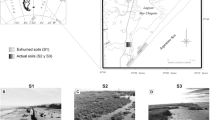Abstract
The ratio of 32S/34S stable isotopes was determined for soils developed on the Maikop clay sediments in the North Caucasus region in order to study the salt geochemistry in the soils. The soil sulfates were proved to be polygenetic. Three groups (generations) of sulfates of different geneses were distinguished according to their isotopic composition (34S). In the underlying deposits and, partially, in the salt-bearing horizons of the soils, secondary sulfates originated from the oxidation of sulfides contained in the marine clay predominate. In the soil profiles, the sulfates inherited from the parent material (marine clay) are mixed with sulfates arriving with the atmospheric precipitation. The portion of the latter reaches about 30% of the total amount of sulfates in the soils. The salt (gypsum)-bearing horizons were formed in the course of the eluvial-illuvial redistribution of salts to the depth of seasonal wetting. The mobilization of sulfate salts from the underlying deposits and their transport to the upper parts of the soil profile with ascending water flows in the course of evaporation from the soil surface did not play a significant role in the accumulation of sulfates in the studied soils.
Similar content being viewed by others
References
A. Ya. Antykov and A. Ya. Stomorev, Soils of the Stavropol Region and Their Fertility (Stavropol, 1970) [in Russian].
E. V. Arinushkina, Handbook on the Chemical Analysis of Soils (Mosk. Gos. Univ., Moscow, 1970) [in Russian].
R. Kh. Aidinyan, M. S. Ivanova, and T. G. Solov’eva, Methods for the Extraction and Determination of Different Sulfur Forms in Soils and Plants (Guidelines) (Moscow, 1975) [in Russian].
V. A. Grinenko and M. V. Ivanov, “The Main Reactions of the Global Biogeochemical Sulfur Cycle,” in Global Biogeochemical Sulfur Cycle (Nauka, Moscow, 1983), pp. 12–32 [in Russian].
M. V. Ivanov, V. A. Grinenko, and A. L. Rabinovich, “Sulfur Flux from the Continents to the Ocean,” in Global Biogeochemical Sulfur Cycle (Nauka, Moscow, 1983), pp. 281–298 [in Russian].
V. A. Kovda, Biogeochemistry of Soil Cover (Nauka, Moscow, 1985) [in Russian].
I. V. Kovda, E. G. Morgun, and T. V. Alekseeva, “Development of Guilgai Soil Cover in the Central Ciscaucasia,” Pochvovedenie, No. 3, 19–34 (1992).
I. V. Kovda, E. G. Morgun, and Ya. G. Ryskov, “Structural and Functional Analysis of Guilgai Soil Microcomplex: Morphological Indices and Water Content Dynamics,” Pochvovedenie, No. 11, 1326–1339 (1995).
V. A. Kovda and E. M. Samoilova, “A New Historical Conception of the Russian Plain Soils,” Pochvovedenie, No. 9, 1–12 (1966).
A. A. Migdisov, V. A. Grinenko, and A. B. Ronov, “Sulfur Reservoir in the Sedimentary Shell and the Earth Crust,” in Global Biogeochemical Sulfur Cycle (Nauka, Moscow, 1983), pp. 32–87 [in Russian].
A. L. Rabinovich, “Isotope Composition of Sulfate Sulfur in Soils of the Southeastern Region of European Soviet Union and Its Forming Factors,” in Development of Saline Lands under Irrigation Conditions (Novocherkassk, 1984), pp. 41–57 [in Russian].
A. L. Rabinovich, Extended Abstract of Candidate’s Dissertation in Chemistry (Novocherkassk, 1971).
Ya. G. Ryskov, S. A. Oleinik, T. V. Alekseeva, et al., “Geochemical Situations in Soils of Associated Landscapes of the Central Ciscaucasia,” Litol. Polezn. Iskop., No. 3, 41–55 (1993).
Ya. G. Ryskov, S. A. Oleinik, E. G. Morgun, and E. M. Samoilova, “Sulfur Isotope Composition as an Index of Salt Genesis in Landscapes of the Stavropol Upland,” Pochvovedenie, No. 4, 36–45 (1989).
L. N. Simonova, I. M. Andreev, A. I. Busev, and E. V. Tupikova, “Comparative Study of Methods for Determining Total Sulfur in Plants,” in Chemical Analysis of Marine Sediments (Nauka, Moscow, 1980), pp. 177–183 [in Russian].
S. P. Sokolovskii, “Reserves of Water-Soluble Salts in Soils and Sediments in Relation to Irrigation,” in Hydrogeological Conditions of Irrigated Lands in the Central Ciscaucasia (Nauka, Moscow, 1965), pp. 30–44 [in Russian].
V. I. Ustinov and V. A. Grinenko, Precision Mass Spectrometric Determination of Sulfur Isotope Composition (Nauka, Moscow, 1965) [in Russian].
J. Freney and C. Williams, “Sulfur Turnover in the Soil,” in Global Biogeochemical Sulfur Cycle (Nauka, Moscow, 1983), pp. 114–153 [in Russian].
L. Bartelli, Workshop on Soil Taxonomy: Correlation and Interpretation (New Delhi, 1971), p. 326.
E. G. Hallsworth and G. G. Beckmann, “Gilgai in the Quaternary,” Soil Sci. 107(6), 407–420 (1969).
H. R. Krouse and R. G. L. McGready, “Biogeochemical Cycling of Sulfur,” in Biogeochemical Cycling of Mineral-Forming Elements, Ed. by P. A. Trudinger and D. I. Schwaine (Elsevier, Amsterdam, 1979), pp. 401–431.
Author information
Authors and Affiliations
Corresponding author
Additional information
Original Russian Text © Ya.G. Ryskov, S.A. Oleinik, E.A. Ryskova, R.F. Khakimov, E.G. Morgun, 2009, published in Pochvovedenie, 2009, No. 1, pp. 8–17.
Rights and permissions
About this article
Cite this article
Ryskov, Y.G., Oleinik, S.A., Ryskova, E.A. et al. The origin of sulfate salts in soils developed on Maikop clays in the North Caucasus region (According to data of the isotope composition of sulfur). Eurasian Soil Sc. 42, 4–12 (2009). https://doi.org/10.1134/S1064229309010025
Received:
Published:
Issue Date:
DOI: https://doi.org/10.1134/S1064229309010025



